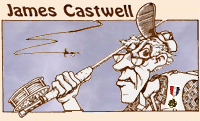
| ||
|
|
|
Emerger: Cut a bit out of the center of the tail (optional) leaving two groups of barbels, shorten as desired. Trim the body closely, but not down to the thread to 3/4 of the length of the hook. At the thorax/head area, trim it a bit larger all around. Nymph: Same fly but to make it into a nymph just trim the head smaller, like the rest of the body. Dun: Divide the tail by removing the center, clip the body tapered and close 3/4 of the length of the hook. Clip the hackle off the bottom and the top leaving one gob sticking up in the middle for wings. Some hackles should be sticking out on both sides and some straight up. Dress it. Spinner: Divide the tails by clipping or leave as is for an extended body style. Clip body tapering to the thorax/head. Trim hackle from the bottom and top, leaving some sticking out both sides. Dress it. Wet: Divide tail as above. Trim body to thorax. Thin this hackle by removing a few all over. They will sweep back once submerged. Terrestrial: Remove tail. Clip hackles at rear of fly to leave a few sticking out on both sides, but not on the top or bottom. Do the same at the front of the fly. It should look like a fly with an X on each end. Dress heavily. Streamer: Do not dress it. Present and fish as a normal streamer. Sinks well.
|
|
|
|
All Previous Castwell Articles If you would like to comment on this or any other article please feel free to post your views on the FAOL Bulletin Board! 
|